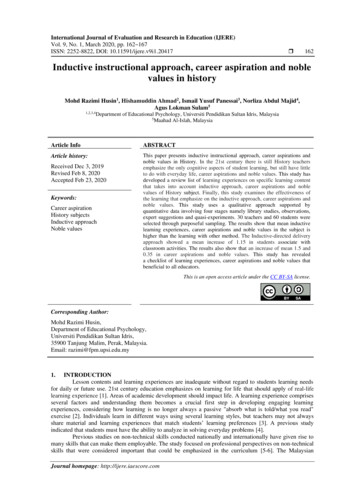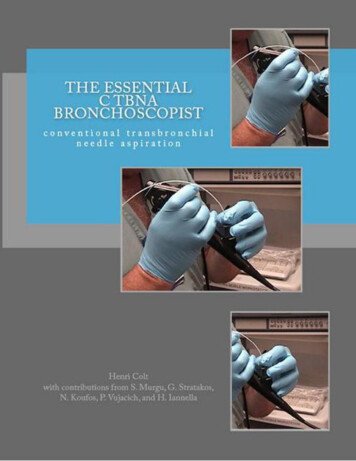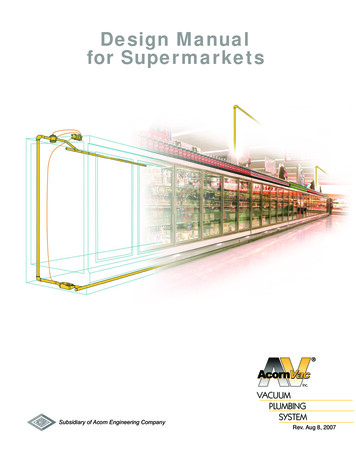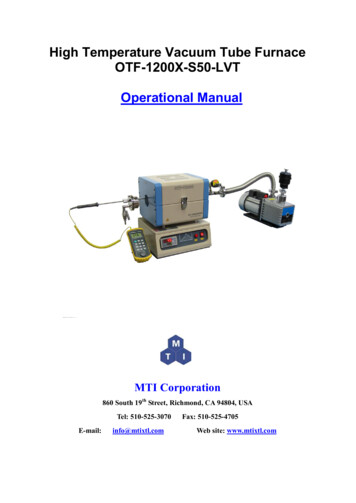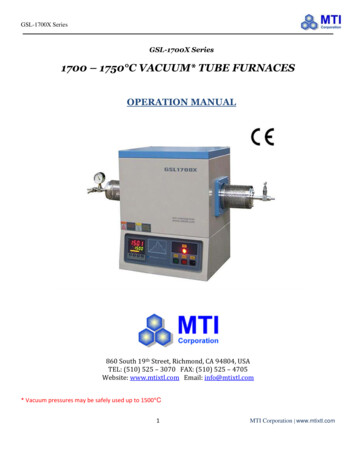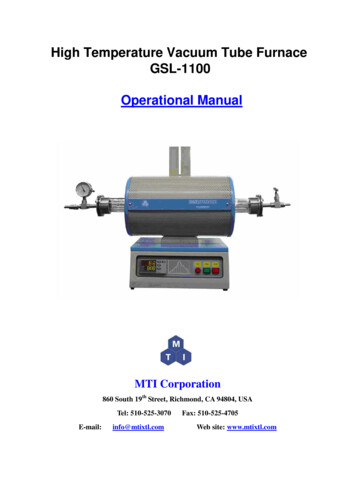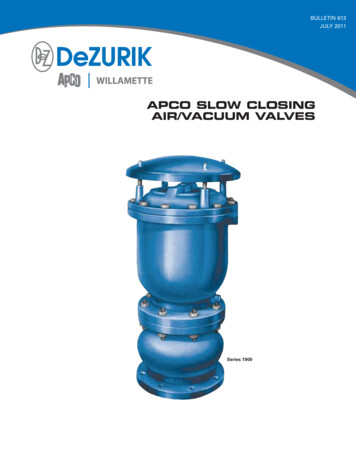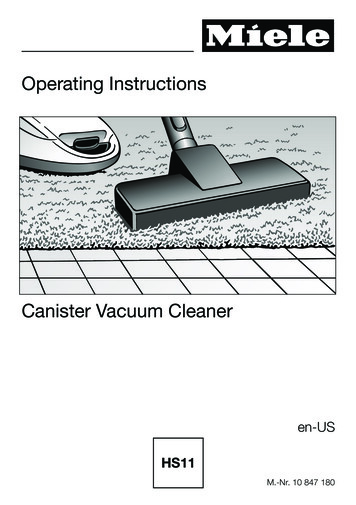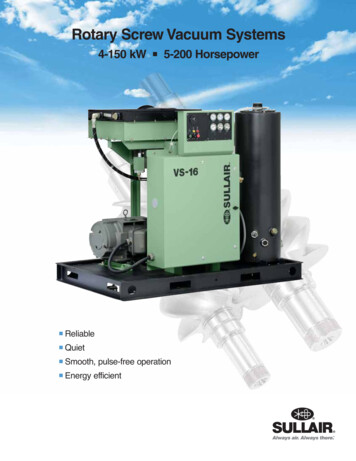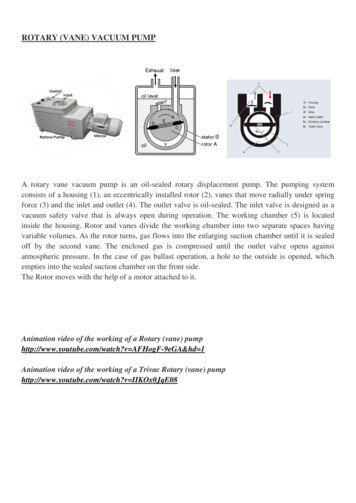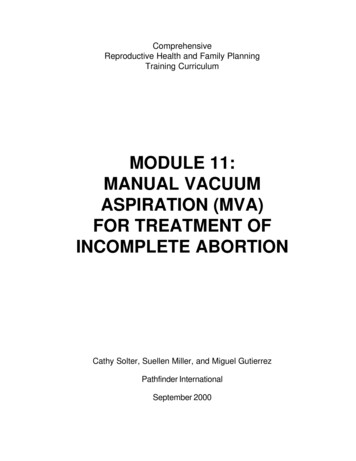
Transcription
ComprehensiveReproductive Health and Family PlanningTraining CurriculumMODULE 11:MANUAL VACUUMASPIRATION (MVA)FOR TREATMENT OFINCOMPLETE ABORTIONCathy Solter, Suellen Miller, and Miguel GutierrezPathfinder InternationalSeptember 2000
2000 Pathfinder International. Any part of this document may be reproduced oradapted to meet local needs without prior permission from Pathfinder Internationalprovided Pathfinder International is acknowledged, and the material is madeavailable free of charge or at cost. Please send a copy of all adaptations from thismanual to:Medical Services UnitPathfinder International9 Galen Street, Suite 217Watertown, MA 02472Funds for this Comprehensive Reproductive Health and Family Planning TrainingCurriculum were provided in part by the Agency for International Development (USAID).The views expressed are those of Pathfinder International and do not necessarilyreflect those of USAID.
ACKNOWLEDGEMENTSThe development of the Comprehensive Reproductive Health and Family PlanningTraining Curriculum, including this module, is an ongoing process and the result ofcollaboration between many individuals and organizations. The development process of thiscurriculum began with the privately funded Reproductive Health Program (RHP) in Viet Nam.This module is a new module based on Miguel Gutierrez’s experience with postabortioncare service delivery in Peru. The module’s design is based on the Family PlanningCourse Modules, produced by the Indian Medical Association in collaboration with Development Associates, Inc. Parts of this curriculum are adapted from the work of: Ipas andWHO for Manual Vacuum Aspiration; JHPIEGO for Infection Prevention; Family HealthInternational (FHI) for Postpartum/Postabortion Contraception; Georgetown University andtheAcademy for Educational Development (AED) for Lactational Amenorrhea Method; andAVSC International for Client’s Rights, Counseling, and Voluntary Surgical Contraception.The entire comprehensive training curriculum was used to train service providers in 1995under this cooperative project which included Pathfinder International, Ipas, AVSCInternational, and the Vietnamese Ministry of Health. Individual modules were used totrain service providers in: Bolivia, Ethiopia, Nigeria (DMPA); Azerbaijan, Bolivia, Ethiopia,Haiti, Kenya, Peru, Tanzania, and Uganda (Infection Prevention); Azerbaijan, Bolivia,Kazakstan, and Peru (Counseling); Jordan (IUD); Bolivia, Kazakstan, and Peru (Trainingof Trainers); Ecuador, Kenya, and Peru (ECP); Ethiopia and Jordan (POPs & COCs); andHaiti (Introduction/Overview). Feedback from these training’s has been incorporated intothe training curriculum to improve its content, training methodologies, and ease of use.With the help of colleagues at Pathfinder International, this curriculum has been improved,expanded and updated to its present form. Many thanks to: Danielle Hassoun and EllenIsrael who assisted in the pre-test of this module; Caroline Crosbie for arranging the pretest in Haiti; Val Montanus who formatted, edited, and managed the production process ofthe pre-test module; Gwyn Hainsworth who designed, edited, formatted, and managed theproduction process of the final module; Anne Read, who designed the cover; RachelMorgan and Jacqueline Gambarini for copy edit; and Michele Wigham-Brown for all herassistance.Colleagues in the field of reproductive health reviewed this training material and providedinvaluable comments and suggestions. These reviewers included:Jean AhlborgCaroline CrosbieMaureen PaulTsigue PleahPhilip StubblefieldRick SullivanLois SchaeferAVSC, ThailandPathfinder International, HaitiPlanned ParenthoodJHPIEGOBoston Medical CenterJHPIEGOJHPIEGO
Module 11Bisi TugboboMary VandenbrouckeJanet YoungPathfinder International, NigeriaPathfinder International, PeruVermont Women’s Health Center, U.S.ASpecial thanks to Jean Ahlborg for the considerable time and energy she devoted to herreview; Dr. Türkiz Gökgöl who was instrumental in the design and development of theoriginal project in Viet Nam; and IPAS for the graphics included in this module.Pathfinder InternationalMVA Curriculum
TABLE OF CONTENTSNotes to the Trainer . i Informed Choice . iii Client Rights . iv Clinical Practicum . v Demonstration Technique . vi Do’s and Don’ts of Training . viiTRAINING GUIDE Overview . 1 Introduction . 7 The impact of unsafe abortion on maternal mortality and morbidity . 13 Unwanted pregnancy as a major cause of unsafe abortion . 15 Sensitivity throughout the postabortion care process. 17 Counseling procedures, skills, and attitudes appropriate for MVA services . 22 Assessment of the condition of a woman presenting with symptoms of anincomplete abortion . 35 Complications of incomplete or septic abortion. 44 Methods of uterine evacuation following incomplete abortion . 66 The preparation of MVA equipment . 70 Infection prevention procedures . 73 Processing the MVA instruments for reuse . 88 Pain control procedures . 100 The PAC MVA procedure . 109 Management of complications related to the MVA procedure . 124 Key issues related to postabortion contraception . 133 Planning for the introduction of postabortion care services . 141 Clinical Practice (Practicum) in Comprehensive Postabortion Care . 147APPENDIXTransparencies . 151 1.1: Consequences of Unsafe Abortion . 151 5.1: Types of Abortion . 152 7.1: Summary of 13 Studies Comparing Vacuum Aspiration and D&C . 153 7.2: Comparison of Complication Rates . 154 7.3: Average Length of Stay for MVA Versus D&C . 155 11.1: Injection Sites for Paracervical Block . 156
Trainer’s Tools . 157 0.1: Pre- and Post-Test Answer Key . 157 4.1: Answer Key to Role Play #1 . 161 4.2: Maintaining a Professional Relationship . 162 4.3: Responding to a Woman’s Feelings . 163 4.4: Fishbowl Exercise . 165 4.5: Observer’s Role Play Checklist . 166 6.1: Signs, Symptoms, and Treatment of Complications . 169 6.2A: Answer Key to Case Studies . 171 6.2B: Answer Key to Case Studies . 172 6.2C: Answer Key to Case Studies . 173 6.6D: Answer Key to Case Studies . 174 9.1: Mind Mapping . 175 13.1: Answer Key to Matching Exercise . 176 13.2A: Answer Key to Case Studies . 177 13.2B: Answer Key to Case Studies . 179 13.2C: Answer Key to Case Studies . 180 13.2D: Answer Key to Case Studies . 181 13.2E: Answer Key to Case Studies . 182 13.2F: Answer Key to Case Studies . 183 13.2G: Answer Key to Case Studies . 184 13.2H: Answer Key to Case Studies. 185 14.1: Postabortion Contraception: Selection Guidelines for Contraceptive . 186 14.2: Family Planning and Informed Choice . 190 14.1: Answer Key to Search and Learn Exercise . 191 16.1: Competency Based Training (CBT) Skills Assessment Checklist. 194 16.2: Counseling and Communication . 195 16.3: Taking the Medical History . 198 16.4: Performing the Physical Examination . 199 16.5: Infection Prevention . 201 16.6: Pain Management . 204 16.7: Performing the MVA Procedure . 205List of Acronyms . 207
Module 11NOTES TO THE TRAINERPURPOSEThis training manual is part of the Comprehensive Reproductive Health and FamilyPlanning Training Curriculum for service providers. It is designed to prepare participantsto provide quality postabortion care to women who come to a health facility for treatment ofincomplete or septic abortion. It is to be used to train physicians, nurses, and midwives.Parts of the module may be adapted for use with community-based workers or auxiliaryworkers.This manual is designed to actively involve participants in the learning process. Sessionsinclude simulation skills practice, discussions, case studies, role plays, and clinicalpractice, using objective knowledge, attitude, and skills checklists.DESIGNThe comprehensive training curriculum consists of 16 roduction/OverviewInfection PreventionCounselingCombined Oral Contraceptives and Progestin-only PillsEmergency Contraceptive PillsDMPA Injectable ContraceptivesIntrauterine DevicesBreastfeeding and Lactational Amenorrhea MethodCondoms and SpermicidesVoluntary Surgical ContraceptionMVA for Treatment of Incomplete AbortionReproductive Tract InfectionsPostpartum/Postabortion ContraceptionTraining of TrainersQuality of CareAdolescent Reproductive HealthIncluded in each module is a set of knowledge assessment questions, Competency-BasedTraining (CBT) skills checklists, trainer resources, participant materials, training evaluationtools, and a bibliography.PARTICIPANT SELECTIONThe modules are meant for mid-level providers of family planning services who alreadyhave some skills and training in women’s reproductive health: nurses, nurse midwives,Pathfinder InternationaliMVA Curriculum
Module 11nurse assistants, physicians, and others. Clinic and program managers also need to havea clear idea of the goals, challenges, and resource requirements of an integrated program,so that they will be supportive and appreciative of provider efforts. For this reason,inclusion of a member of management staff, either in the training itself or in a separatesensitization, is highly desirable. All clinic staff, including the receptionist and otherauxiliary personnel, should be sensitized to caring for women who come to the facility forpostabortion care. This can be accomplished by giving a short course to these staff usingSpecific Objectives 1, 2, and 3.USING THE MODULES The modules provide flexibility in planning, conducting, and evaluating the trainingcourse. The curriculum allows trainers to formulate their own training schedule, based onresults from the training needs assessments. The modules can be used independently of each other. The modules can also be lengthened or shortened depending on the level of trainingand expertise of the participants. In order to foster changes in behavior, learning experiences have to be in the areas ofknowledge, attitudes, and skills. In each module, general and specific objectives arepresented in terms of achievable changes in these three areas. Training references and resource materials for trainers and participants are identified. This module is d
Module 11 Pathfinder International ii MVA Curriculum nurse assistants, physicians, and others. Clinic and program managers also need to have a clear idea of the goals, challenges, and resource requirements of an integrated program, so that they will be supportive and appreciative of provider efforts. For this reason, inclusion of a member of management staff, either in the training itself or .
